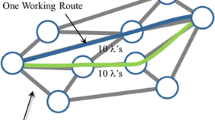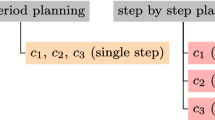Abstract
This paper studies the long-term planning (e.g. a planning horizon of 2 to 5 years) of survivable WDM networks. The problem is formulated as a multi-period model that combines network topology and capacity expansion. The ability to determine network expansion schedules of this type becomes increasingly important to the telecommunications industry and to its customers. Two inherently different solution methods are presented: a sequential single-period approach, which designs the networks for every time period separately in chronological order, and an integrated multi-period approach, which considers all time periods at once. For each of these approaches, different network design cost models can be applied. Extensive simulations on a wide range of problem instances are carried out, to measure the influence of the applied network design cost model and to assess the cost savings that can be expected by opting for a multi-period planning approach instead of a sequential network design method.
Similar content being viewed by others
References
K. Sato, Advances in Transport Network Technologies (Artech House, Norwood, 1996).
P. Lagasse, et al., Photonic Technologies in Europe, Horizon-Infowin (ACTS), Telenor AS R&D, (1998).
G. Hill, et al., A transport network layer based on optical network elements, Journal of Lightwave Technology, vol. 11, no.5/6 (1993), pp. 667–679.
R. Ramaswami, Multi-Wavelength Lightwave Networks for Computer Communication, IEEE Communications Magazine, vol. 31, no.2 (1993), pp. 78–88.
A. Acampora, The Scalable Lightwave Network, IEEE Communications Magazine, vol. 32, no.12, (1994), pp. 36–42.
P. Green, Optical Networking Update, IEEE Journal on Selected Areas in Communications, vol. 14, no.5 (1996), pp. 764–779.
R. Ramaswami, K. Sivarajan, Design of Logical Topologies for Wavelength-Routed Optical Networks, IEEE Journal on Selected Areas in Communications, vol. 14, no.5 (1996), pp. 840–851.
N. Wauters, P. Demeester, Design of the Optical Path Layer in Multi-wavelength Crossconnected networks, IEEE Journal on Selected Areas in Communications, vol. 14, no.5, (1996), pp. 881–892.
S. Baroni, P. Bayvel, Wavelength Requirements in Arbitrarily Connected Wavelength-Routed Optical Networks, Journal of Lightwave Technology, vol. 15, no.2, (1997), pp. 242–251.
B. Van Caenegem, W. Van Parys, F. De Turck, P. Demeester, Dimensioning of Survivable WDM Networks, IEEE Journal on Selected Areas in Communications, vol. 16, no.7, (1998), pp. 1146–1157.
S. Chang, B. Gavish, Telecommunications Network Topological Design and Capacity Expansion: Formulation and Algorithms, Telecommunication Systems, vol. 1, (1993), pp. 99–131.
S. Chang, B. Gavish, Tight Lower Bounding Procedures for Multi-Period Telecommunications Network Expansion Problems, Proc. of First International Conference on Telecommunication Systems (Nashville, TN, March 1993), pp. 4–18.
N. Zadeh, On Building Minimum Cost Communication Networks over Time, Networks, vol. 4, (1974), pp. 19–34.
N. Christofides, P. Brooker, Optimal Expansion of an Existing Network, Mathematical Programming, vol. 6, (1974), pp. 197–211.
P. Doulliez, R. Rao, Optimal Network Capacity Planning: a Shortest Path Scheme, Operations Research, vol. 23, (1975), pp. 811–818.
M. Minoux, Network Synthesis and Dynamic Network Optimization, Annals of Discrete Mathematics, vol. 31, (1987), pp. 283–324.
B. Garcia, P. Mahey, L. Leblanc, Iterative Improvement Methods for a Multi-Period Network Design Problem, European Journal of Operations Research, vol. 110, no.1, (1998), pp. 150–165.
A. Balakrishnan, T. Magnanti, A. Shulman, R. Wong, Models for Planning Capacity Expansion in Local Access Telecommunication Networks, Annals of Operations Research, vol. 33, (1991), pp. 239–284.
T. Wu, R. Cardwell, M. Boyden, A Multi-Period Design Model for Survivable Network Architecture Selection for SONET Interoffice Networks, IEEE Transactions on Reliability, vol. 40, no.4, (1991), pp. 417–427.
S. Parrish, T. Cox, W. Kuehner, Y. Qiu, Planning for Optimal Expansion of Leased Line Communication Networks, Annals of Operations Research, vol. 36, (1992), pp. 347–364.
M. Pickavet, P. Demeester, Multi-Period Planning of Survivable WDM Networks, accepted for publication in European Transactions on Telecommunications, special issue on WDM networks, 2nd semester 1999.
N. Wauters, G. Ocacoglu, K. Struyve and P. Falcao, Survivability in a new pan-European Carriers' Carrier Network based on WDM and SDH Technology: Current Implementation and Future Requirements, to be published in IEEE Communications Magazine, vol. 37, no.8, Aug. (1999).
T. Wu, Emerging Technologies for Fiber Network Survivability, IEEE Communications Magazine, vol. 33, no.2, (1995), pp. 58–74.
L. Ford, D. Fulkerson, Maximal Flow through a Network, Canadian Journal of Mathematics, vol. 8, (1956), pp. 399–404.
C. Monma, D. Shallcross, Methods for Designing Communications Networks with Certain Two-Connected Survivability Constraints, Operations Research, vol. 37, no.4, (1989), pp. 531–541.
M. Grötschel, C. Monma, M. Stoer, Design of Survivable Networks, in Handbooks of Operations Research and Management Science, vol.7 (M. Ball, T. Magnanti, C. Monma, G. Nemhauser, Ed.), North-Holland, Amsterdam, 1995, pp. 617–672.
M. Pickavet, F. Poppe, J. Luystermans, P. Demeester, A Genetic Algorithm for Solving the Capacitated Survivable Network Design Problem, Proc. of Fifth International Conference on Telecommunication Systems (Nashville, TN, March 1997), pp. 71–76.
M. Pickavet, P. Demeester, A Zoom-In Approach to Design Mesh Restorable Networks, accepted for publication in Journal of Heuristics (special issue on Telecommunication), Kluwer, Norwell.
Author information
Authors and Affiliations
Rights and permissions
About this article
Cite this article
Pickavet, M., Demeester, P. Long-Term Planning of WDM Networks: A Comparison between Single-Period and Multi-Period Techniques. Photonic Network Communications 1, 331–346 (1999). https://doi.org/10.1023/A:1010030918159
Issue Date:
DOI: https://doi.org/10.1023/A:1010030918159




